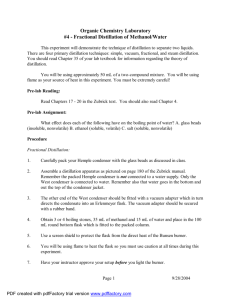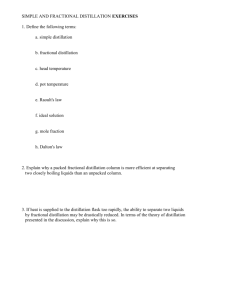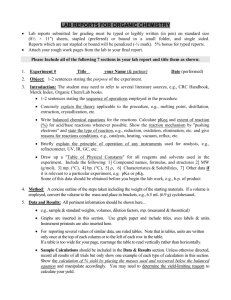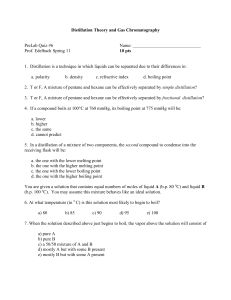Prelab Distillation
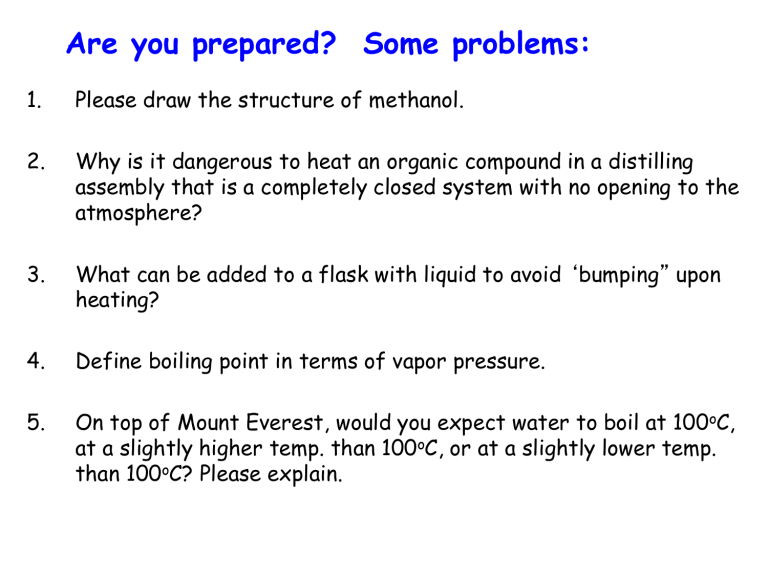
Are you prepared? Some problems:
1.
Please draw the structure of methanol.
2.
Why is it dangerous to heat an organic compound in a distilling assembly that is a completely closed system with no opening to the atmosphere?
3.
What can be added to a flask with liquid to avoid ‘ bumping ” upon heating?
4.
Define boiling point in terms of vapor pressure.
5.
On top of Mount Everest, would you expect water to boil at 100 o C, at a slightly higher temp. than 100 o C, or at a slightly lower temp. than 100 o C? Please explain.
Third Lab: Distillation
“ Experimental Organic Chemistry ” by Wilcox & Wilcox
Chapter 5, pages 43-69
What is distillation?
Distillation is a laboratory technique for the purification of liquid compounds that takes advantage of different boiling points.
What are the most common techniques for compound purification?
Most common techniques for compound purification:
• Crystallization
(solids)
• Extraction
(solids or liquids)
• Chromatography
(solids or liquids)
• Distillation
(liquids)
Vapor pressure - facts
• A liquid placed in a flask starts to evaporate until the pressure exerted by the gaseous molecules reaches equilibrium. (No more liquid evaporates.) The equilibrium pressure is the vapor pressure.
• The vapor pressure is typically expressed in mm Hg (= torr).
• The vapor pressure always increases as temperature increases.
• The vapor pressure is a constant characteristic for a particular material at a specific temperature.
Boiling point - definition
a) Of a pure liquid
The temperature at which the vapor pressure of the liquid equals the external pressure (usually atmospheric pressure).
b) Of a mixture of liquids
The temperature at which the total vapor pressure ( = sum of the partial vapor pressures) equals the external pressure.
The Distillation Apparatus ( “ Still ” )
A liquid is boiled, and the vapors are condensed in the condenser.
The condensate
(distillate) is collected in the receiving flask.
Different types of distillation
• Simple – used for almost pure liquids or for mixtures of liquids with very different boiling points.
• Fractional – used for mixtures with similar boiling points. A column is required, e.g. a
Vigreux column
• Vacuum – used for liquids with high boiling points (> 150 o C).
• Steam – used for heat sensitive compounds that are not water-miscible.
Bumping
• Superheated liquids can spontaneously “ bump ” . This is a boiling retardation.
• Is that bad? YES !!!! a) It is a potential hazard . (Example: superheated coffee in the microwave oven) b) The undistilled mixture “ bumps ” over into the receiving flask (no purification!)
• Where does bumping come from? --> When the surface does not have enough microscopic air pockets .
• Solution: Add boiling chips to the liquid before heating. The boiling chips are a source of air bubbles.
Today ’ s lab experiment:
• Distillation of CH
3
OH
• Distillation of a CH
3 mixture
OH/H
2
O
In this context, understand a) “ boiling point diagram ” b) “ distillation curve ”
Boiling point diagram of CH
3
OH/H
2
O
• Methanol and water are fully miscible.
• Diagram is unsymmetrical (distortion).
• Methanol/water mix is a non-ideal mixture , i.e. the vapor pressures of the components influence each other.
• The vapor of the boiling mixture is richer in methanol.
Boiling point diagram of CH
3
CH
2
OH/H
2
O
• Ethanol and water are fully miscible.
• Diagram is unsymmetrical (distortion).
• Ethanol/water mix is a non-ideal mixture.
• The vapor of the boiling mixture is richer in ethanol.
• At a certain composition range, ethanol and water distill over together as an azeotrope .
An azeotrope is a mixture of two or more liquids whose proportions cannot be changed by distillation because the vapor has the same proportions of constituents as the unboiled mixture.
The boiling point of pure water is 100 o C.
The boiling point of pure ethanol is 78.4
o C.
The azeotrope of an ethanol-water mixture has a boiling point of 78.1
o C.
Distillation curves for methanol/water
• Simple distillation
• Fractionated distillation with columns
• Can you estimate the ratio of this methanol/ water mixture?
Laboratory procedures, 5.4 A,B
(Wilcox & Wilcox, p. 66)
1.
Set up your distillation apparatus.
2.
Instead of a receiving flask, use a graduated cylinder.
3.
Fill flask about half with methanol or a methanol/water mixture. according to TA instructions.
4.
Add one or two boiling chips.
5.
Turn on cooling water. Tubing must be properly secured.
6 Apply heat. If you are using an electric heating mantle, do not plug heating mantle directly into power outlet.
Power must be controlled with a controller.
7.
Record the distilling temperature and the volume of the distillate in order to create a distillation curve.
8.
Do not distill all the way to dryness.
Leave a couple of mL in the flask. (Why?)
9.
Discard the distilled liquid into the organic solvent waste (nonhalogenated).
10. Compare your distillation curve with the distillation curve of other groups.



